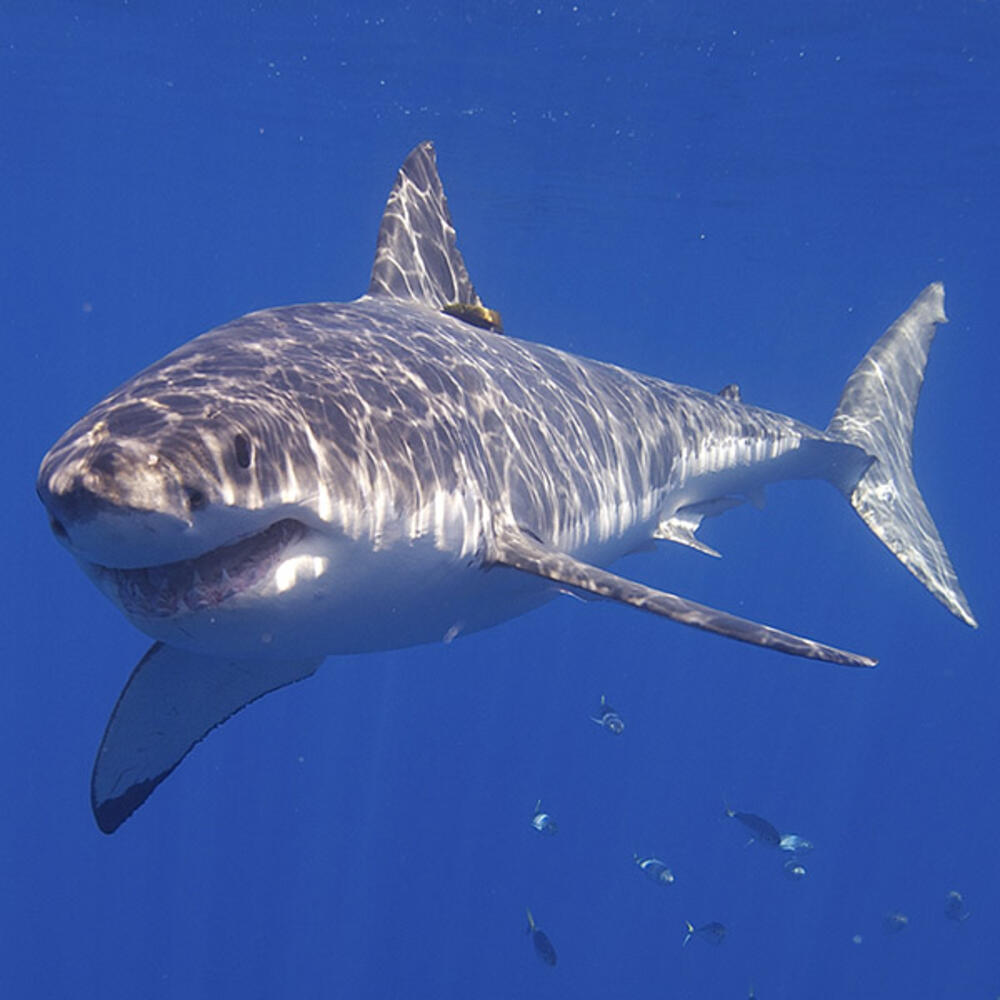Sharks
December 15, 2021 — September 4, 2023
Now Open
Additional ticket required. Free for Members.
Floor 3, Gallery 3

D. Finnin/© AMNH
Older than dinosaurs—and more threatened than threatening—sharks are spectacular, surprising, and often misunderstood. Discover the incredible diversity of this ancient and fascinating group of fishes.
[INTENSE DRUMS]
A large shark appears just below the surface of the water, and bites the side of a boat, showing its teeth. The screen cuts to black.
JOHN SPARKS (Curator, Sharks exhibition, American Museum of Natural History): The public perception of sharks is that they are…
[INTENSE DRUMS]
A great white shark breaches the water and comes crashing down into the ocean with its mouth open, showing its teeth. The screen cuts to black.
SPARKS: … large vicious predators…
[INTENSE MUSIC]
A shark swims past and then turns to face the camera swiftly.
SPARKS: … that are to be feared when you go in the water.
Nurse sharks swarm beneath the surface of the water in a marina. A hammerhead shark swims towards the camera as the American Museum of Natural History logo appears onscreen. SPARKS appears on screen speaking to camera. Text on screen reads “John Sparks, Curator, Sharks.”
SPARKS: We want sharks to be revered and not feared.
A whale shark, viewed from behind the tail, glides through the ocean.
SPARKS: Sharks, rays, skates, chimaeras–
A large group of rays swarm in a ball.
SPARKS: –go back somewhere well over 400 million years.
Inside the American Museum of Natural Histor, a huge megalodon jaw hangs in a hall. The camera cuts to a close-up of its teeth.
SPARKS: That’s older than flowering plants, it’s older than trees–
In the Museum collections, someone pulls out a tray of huge fossil shark teeth.
SPARKS: –and that pre-dates the dinosaurs by almost 200 million years.
An angelfish (a shark that looks somewhat ray-like) and a sawfish (a ray with a huge spiky saw-like nose) appear on screen.
SPARKS: And they’ve diversified into all these different groups–
A deep-sea chimaera swims slowly facing the camera.
SPARKS: –very few of which actually attack humans.
A huge manta ray glides slowly over the sandy sea floor. A deep-sea sixgill shark swims among deep-sea organisms.
SPARKS: We hope visitors will walk away from this exhibit with a new appreciation for sharks–
A bull shark swims over a sea floor of soft corals and small sea creatures.
SPARKS: –not as vicious eating machines–
A whale sharks swims past the camera.
SPARKS: –but as a very long-lived, diverse group of organisms–
A silky shark glides along a coral reef, and a tiger shark swims alongside other fish.
SPARKS: –that are critical to the habitats in which they live.
Credits roll.
[END MUSIC]
Select the number of tickets, and date/time for Museum entry, and you will be then able to add Sharks, and/or additional Ticketed Exhibitions during checkout.
What You’ll See in Sharks
D. Finnin/© AMNH
D. Finnin/© AMNH
D. Finnin/© AMNH
D. Finnin/© AMNH
D. Finnin/© AMNH
The new exhibition Sharks features dozens of life-sized models ranging from 33 feet to 5.5 inches long, fossils from the Museum’s collections, touch-free interactive exhibits that challenge visitors to hunt like a hammerhead, and more for visitors of all ages.
Ancient Sharks
Around 450 million years ago, one branch of fishes—ancient relatives of shark—split off from the rest. Unlike most fishes, which have bony skeletons, this branch of the tree has skeletons made of cartilage.
Come face-to-face with a life-sized model of megalodon, the biggest predatory fish of all time, and see fossils of other extinct species, including Helicoprion, nicknamed the buzzsaw shark.
Teeth and Jaws
Humans replace our “baby” teeth just once. But sharks replace their teeth every few weeks, over and over, for their entire lives.
Explore an array of 12 casts of jaws and teeth of various shark species, from a great white shark’s serrated teeth for hunting seals to a zebra shark’s small, sharp teeth, specialized to chew though shells.
Biggest to Smallest Sharks
The biggest fish in the world is a shark—but other sharks are tiny. Why? The size of each species depends on how it evolved and adapted to its environment.
Discover why whale sharks achieve enormous sizes, and see models of the smallest shark species that live deep in the sea and make their own light—both so small you could hold one in your hand.
Super Sensors
Sharks, rays, skates, and chimaeras have evolved some extraordinary sensing abilities. They can even detect things humans aren’t aware of—including electromagnetic fields and the direction of very low-frequency sounds.
Find out how swell sharks use their glowing patterns in dimly lit water, and see a largetooth sawfish blade, which has sensors that help sharks and relatives detect prey using electroreception.
 Courtesy of E. Levy/Flickr
Courtesy of E. Levy/Flickr
The Museum gratefully acknowledges Warner Bros. Discovery for its generous support of Sharks. A selection of footage in Sharks has been provided by Discovery's Shark Week.
Sharks is supported by Robert F. Gossett, Jr.